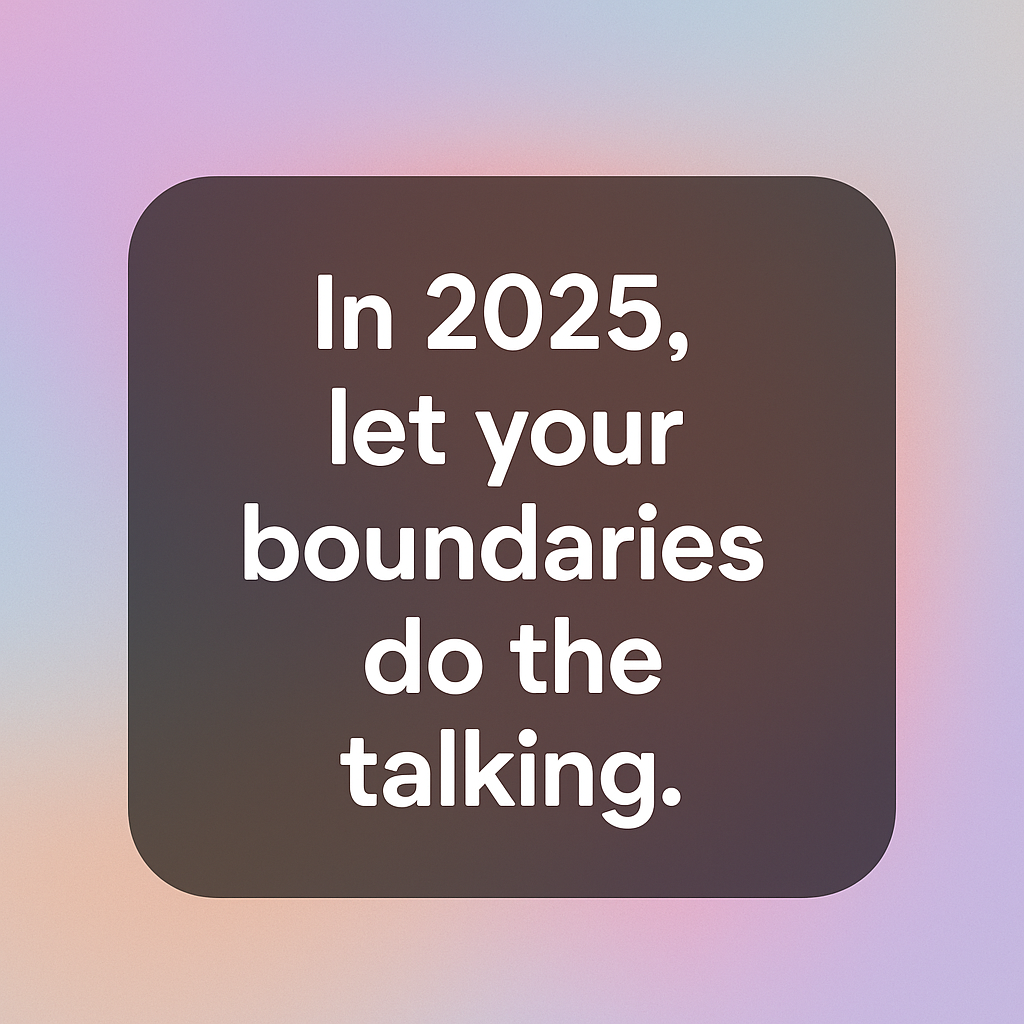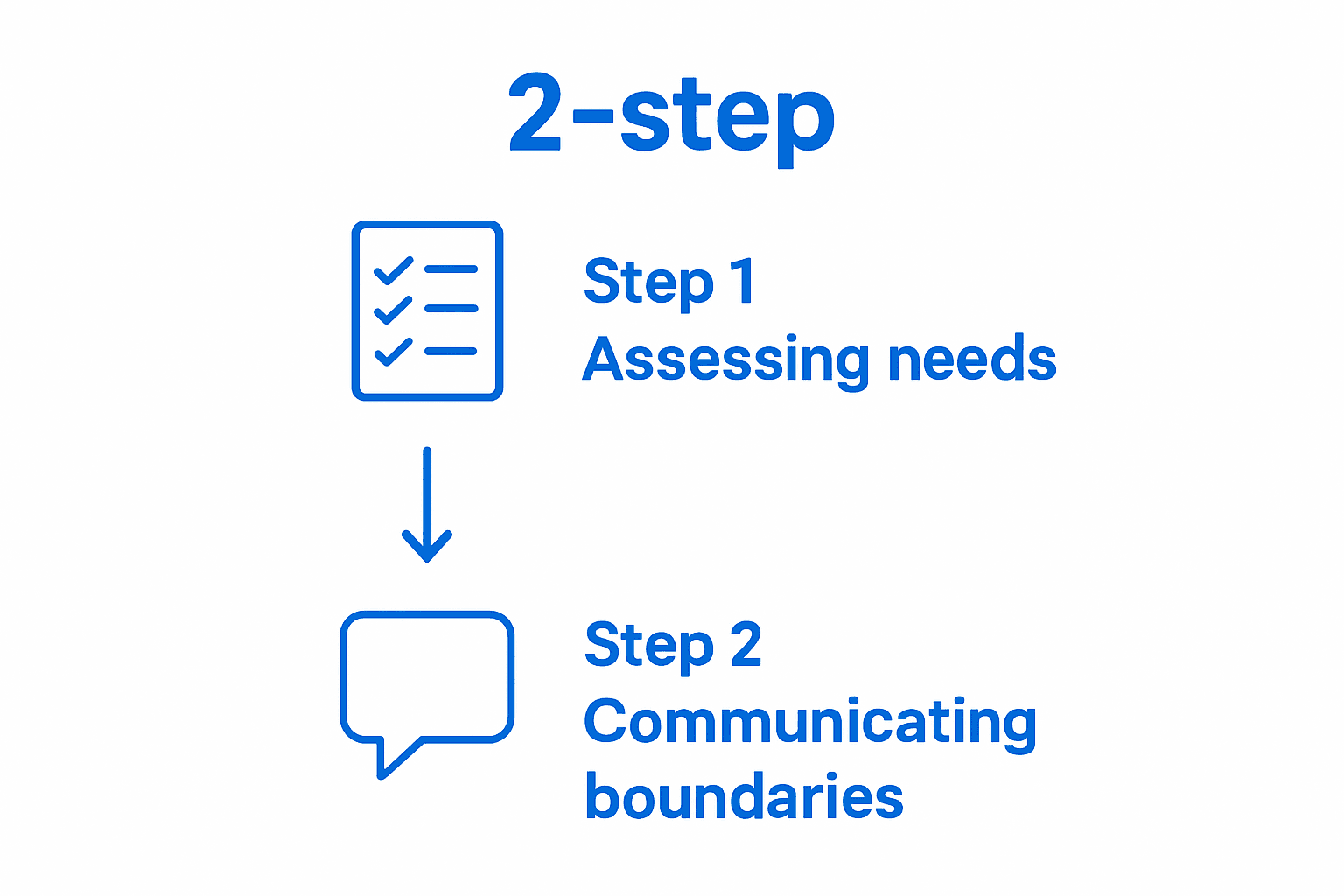
How to Set Boundaries for Your Success in 2025? Setting boundaries at work and in your personal life sounds simple enough and yet over 60 percent of professionals report struggling to actually enforce them. That statistic flips assumptions upside down. Turns out, effective boundaries are less about saying no and much more about knowing how and when to adjust your limits for real growth.
Table of Contents
- Step 1: Identify Your Limitations And Needs
- Step 2: Communicate Boundaries Clearly
- Step 3: Implement Consequences For Boundary Violations
- Step 4: Ensure Consistency In Your Boundaries
- Step 5: Evaluate And Adjust Your Boundaries Regularly
Quick Summary
| Key Point | Explanation |
|---|---|
| 1. Identify personal limitations clearly | Conduct a self-assessment to understand where you feel overwhelmed and what drains your energy. |
| 2. Communicate boundaries with clarity | Use direct, respectful language to articulate your limits, ensuring mutual understanding with others. |
| 3. Implement consequences for violations | Establish a graduated response system to enforce your boundaries consistently and fairly when they are crossed. |
| 4. Maintain consistency in enforcing boundaries | Develop systems and use technology to ensure your boundaries are followed, promoting respect in professional interactions. |
| 5. Regularly evaluate and adjust boundaries | Conduct quarterly reviews to adapt your boundaries as your life and professional circumstances change. |
Step 1: Identify Your Limitations and Needs
Successfully learning how to set boundaries begins with a critical self-assessment of your personal and professional limitations. This foundational step requires honest introspection about what truly matters to you and what drains your energy, productivity, and emotional well-being. Understanding personal boundaries is more than a theoretical exercise it is a strategic approach to protecting your time, mental health, and professional growth.
Self-Discovery Through Reflection
Start by creating a comprehensive personal inventory of your current challenges and emotional triggers. Consider your typical work week: Where do you feel overwhelmed? Which interactions consistently leave you feeling depleted? What tasks consume disproportionate amounts of your time and mental bandwidth?
Reflect on specific scenarios where you have felt uncomfortable, overextended, or unable to maintain professional composure. These moments are powerful indicators of where boundaries need reinforcement. For instance, if client communications frequently extend beyond scheduled hours or project scope, this signals a clear boundary requirement.
The goal is not to create rigid walls but to design flexible, healthy frameworks that support your well-being and professional effectiveness. Effective boundaries are about clarity, respect, and mutual understanding. They communicate your limits while maintaining professional relationships and personal integrity.
To systematically map your boundaries, consider creating a personal assessment document that categorizes different life and work domains:
- Emotional energy and availability
- Professional time and communication expectations
- Personal space and interruption tolerance
- Work hour limitations
- Communication response timelines
This structured approach transforms boundary setting from an abstract concept into a tangible, actionable strategy. By documenting your specific needs and limitations, you create a reference point for future interactions and decision making.
Below is a summary table of common types of boundaries to assess, helping you map out specific areas in your personal and professional life where limits may be needed.
| Boundary Type | Description | Example Trigger |
|---|---|---|
| Emotional energy and availability | How you manage emotional output and protect mental well-being | Feeling drained after certain meetings |
| Professional time and communication | Guidelines for managing your work schedule and interactions | Frequent after-hours work emails |
| Personal space and interruption | Limits on physical or digital interruptions during work or rest | Family interruptions during work hours |
| Work hour limitations | Restrictions on when you are available for work tasks | Requests for meetings outside work hours |
| Communication response timelines | Timeframes for replying to messages or requests | Expectation of instant replies |

Remember that boundary identification is an ongoing process. Your limits will evolve as your professional journey progresses, so regularly revisit and refine your understanding of personal and professional boundaries. Approach this step with compassion for yourself, recognizing that setting boundaries is a skill that improves with practice and self awareness.
Step 2: Communicate Boundaries Clearly
Communicating boundaries is an art form that requires precision, confidence, and empathy. After identifying your personal limitations, the next crucial step is articulating them in a manner that is respectful, clear, and constructive. Effective communication strategies demonstrate that boundaries are not about creating distance, but about establishing mutual understanding and professional respect.
The most powerful boundary communication combines directness with compassion. Start by using clear, concise language that leaves no room for misinterpretation. Instead of apologetic or vague statements, craft messages that are straightforward yet kind. For example, replace “I might not be available” with “My work hours are from 9 AM to 5 PM, and I respond to messages during those times.”
Practice delivering your boundary statements with a calm, neutral tone. Your body language and vocal inflection are equally important as the words themselves. Maintain eye contact, speak steadily, and avoid defensive or aggressive postures. When communicating boundaries in professional settings, frame them as collaborative agreements rather than unilateral declarations.
Written communication channels offer additional opportunities for boundary setting. Create template responses for common scenarios that clearly outline your availability, response times, and professional expectations. For digital communications, consider implementing autoresponders or standard email signatures that subtly reinforce your boundaries.
Anticipate potential pushback or misunderstandings by preparing concise explanations for your boundaries. Be ready to articulate the reasoning behind your limits without becoming defensive. For instance, if you are establishing strict project consultation hours, explain how this approach ensures focused, high quality service for all clients.
Verify that your boundaries have been understood by asking for acknowledgment. After communicating a boundary, you might say, “Does this approach work for you?” or “Let me know if you have any questions about my availability.” This approach invites dialogue and demonstrates your commitment to clear, respectful communication.
Remember that boundary communication is an ongoing process. Your initial conversations are just the beginning. Be prepared to reinforce your boundaries consistently and kindly. Each time you clearly communicate your limits, you are not just protecting your professional space you are modeling healthy workplace interactions for others.
Step 3: Implement Consequences for Boundary Violations
Boundaries without consequences are merely suggestions. The true strength of personal and professional limits lies in your commitment to enforcing them consistently and fairly. Research on behavioral psychology demonstrates that clear, predictable responses to boundary violations are essential for long term respect and mutual understanding.
Establishing a graduated response system is critical for effective boundary management. Think of consequences as a professional escalation process, not as punitive measures. The goal is not to penalize but to reinforce the importance of mutual respect and agreed upon professional standards.
Begin by developing a clear, documented protocol for how you will respond to different types of boundary infractions. For client interactions, this might involve a tiered approach. A first time minor violation could trigger a gentle reminder and restatement of your original boundary. Repeated or more significant violations might result in more substantial actions, such as extending project timelines, adjusting communication channels, or ultimately reconsidering the professional relationship.
In practice, this means creating specific scripts or response templates for various scenarios. For instance, if a client consistently contacts you outside agreed work hours, your first response might be a polite but firm redirection. A follow up violation could involve a more direct communication about the potential impact on project deliverables or service quality.
Professional consequences should always be:
- Proportional to the boundary violation
- Clearly communicated in advance
- Consistently applied
- Focused on maintaining professional integrity
- Designed to protect your time and energy
Emotional intelligence plays a crucial role in implementing consequences. Approach boundary enforcement with calm professionalism, avoiding reactive or aggressive responses. Your objective is to maintain a constructive dialogue while firmly protecting your established limits.
Documentation becomes your ally in this process. Keep records of boundary violations and your corresponding responses. This not only provides a clear history of interactions but also helps you identify patterns and refine your boundary management strategy over time.
Remember that implementing consequences is not about creating conflict but about establishing a framework of mutual respect. Each time you consistently enforce a boundary, you are training your professional network to interact with you more effectively. View this step as an investment in your long term professional relationships and personal well being.
Step 4: Ensure Consistency in Your Boundaries
Consistency transforms boundary setting from a theoretical concept into a powerful personal management strategy. Scientific research confirms that predictable behavior reinforces respect and understanding in professional relationships. Consistency is not about perfection, but about reliable, intentional action.
To maintain boundary consistency, develop a systematic approach that integrates your limits into daily workflows. Create templated responses, automated communication protocols, and personal reminder systems that support your established boundaries. For instance, if you have defined specific client communication hours, configure email autoresponders and update your professional profiles to reflect these expectations.
Technology can be a powerful ally in maintaining consistency. Utilize digital tools like scheduling applications, communication management platforms, and productivity trackers that help enforce your predetermined boundaries. These systems act as external accountability mechanisms, reducing the mental load of constant boundary management.
Your commitment to consistency requires periodic self reflection and adjustment. Schedule quarterly personal reviews where you assess the effectiveness of your current boundary strategies. During these reviews, ask critical questions: Are my boundaries serving my professional goals? Have I been maintaining them effectively? What adjustments might improve my approach?
Potential consistency challenges to anticipate include:
- Emotional fatigue from constant boundary reinforcement
- Professional environments that test your limits
- Personal tendencies to revert to old, less healthy patterns
- Unexpected high pressure situations
Developing a resilient mindset is crucial for maintaining boundaries. Recognize that occasional lapses do not negate your entire boundary setting process. When you encounter a slip, treat it as a learning opportunity rather than a failure.

Quickly recalibrate and return to your established guidelines.
This table provides an overview of potential challenges to boundary consistency and practical strategies to address them, supporting sustained boundary management in your daily routine.
| Consistency Challenge | Description | Recommended Countermeasure |
|---|---|---|
| Emotional fatigue | Feeling worn out from constant enforcement | Schedule regular self-care and breaks |
| Boundary testing by others | Colleagues or clients pushing established limits | Set firm, polite reminders |
| Reverting to old habits | Returning to less healthy, familiar patterns | Use reminders and periodic reflection |
| High-pressure or unexpected situations | Emergencies causing unintentional boundary breaches | Recalibrate and communicate promptly |
| Inconsistent application of boundaries | Enforcing rules with some people but not others | Use templates and standard responses |
Communicate your commitment to consistency with the professionals in your network. When you demonstrate unwavering dedication to your established boundaries, you educate others about your professional standards. This proactive approach reduces future boundary challenges and cultivates a culture of mutual respect.
Remember that consistency is a skill that improves with practice. Each time you hold firm to your boundaries, you are not just protecting your professional space you are building a reputation for reliability, self respect, and clear communication. Approach this step with patience, understanding that true consistency emerges from persistent, mindful effort.
Step 5: Evaluate and Adjust Your Boundaries Regularly
Boundary setting is not a static process but a dynamic, evolving practice that requires continuous refinement. Psychological research on personal development underscores the importance of adaptability in maintaining effective personal and professional boundaries. Your boundary strategy should be a living framework, responsive to your changing life circumstances and professional landscape.
Implement a structured quarterly review process to assess the effectiveness of your current boundary approach. During these reviews, create a comprehensive evaluation framework that examines multiple dimensions of your boundary implementation. Consider how your boundaries impact your emotional well being, professional productivity, personal relationships, and overall life satisfaction.
Develop a personal boundary audit tool that allows you to objectively measure the success of your current strategies. This might involve tracking metrics such as stress levels, work life balance, client satisfaction, and personal energy reserves. Quantifying these aspects provides concrete evidence of whether your boundaries are serving their intended purpose.
Recognize that professional growth often necessitates boundary adjustments. As your career evolves, your boundaries will need to flex and adapt. What worked effectively in the early stages of your professional journey may require significant modifications as you take on more complex roles or expand your service offerings.
Key areas to evaluate during your boundary review include:
- Emotional and physical energy expenditure
- Professional relationship dynamics
- Personal time and space management
- Career progression and goal alignment
- Stress and burnout indicators
Approach boundary adjustment with curiosity and compassion, rather than self criticism. View each adjustment as an opportunity for personal growth and professional refinement. Some boundaries might need tightening, while others could benefit from greater flexibility.
Utilize technology and journaling to track your boundary evolution. Digital tools can help you log boundary challenges, successful implementations, and recurring patterns. Consider creating a digital or physical boundary journal where you document your observations, insights, and strategic adjustments.
Remember that boundary adjustment is a skill that improves with practice. Each review provides valuable insights into your personal and professional needs. By maintaining an adaptive, intentional approach to boundary setting, you create a sustainable framework for long term success and personal well being. Your boundaries are not a constraint but a powerful tool for personal empowerment and professional excellence.
Unlock Consistent Business Boundaries With Smart Automation
Building strong boundaries is the first step, but holding them becomes tough when endless client tasks and constant notifications eat away at your focus and energy. If you are a solopreneur or freelancer, managing emails, bookings, payments, and marketing can make it almost impossible to honor your time limits, keep your workflow consistent, and protect your emotional well-being—exactly what you learned about in this guide on setting boundaries for your success.

Imagine a business system that enforces your boundaries for you, so you can focus on what really matters. Fluum.ai acts like your AI-powered co-founder, helping you display your availability, automate client communication, and handle scheduling, payments, and marketing with zero hassle. No more blurred lines. No more late-night work. Explore the all-in-one platform built for service providers who want to deliver quality work and nurture growth without sacrificing their boundaries. Ready to see how automation makes your boundaries stronger? Visit our pricing page to start your transformation today.
Frequently Asked Questions
How can I identify my personal limitations when setting boundaries?
To identify your personal limitations, engage in honest self-reflection about your emotional triggers and evaluate your typical work week. Note moments when you feel overwhelmed to determine where boundaries may be necessary.
What are effective strategies for communicating my boundaries?
Effective strategies for communicating boundaries include using clear, concise language, maintaining a calm tone, and framing your boundaries as collaborative agreements. Consider written templates for common scenarios to ensure consistent communication.
How should I handle violations of my boundaries?
When boundaries are violated, establish a graduated response system that ranges from gentle reminders to more significant actions depending on the severity of the violation. Ensure your responses are consistent, clearly communicated in advance, and focused on maintaining professional integrity.
Why is consistency important when setting boundaries?
Consistency is crucial in boundary setting as it reinforces respect and understanding in professional relationships. Regular application of your boundaries helps model healthy interactions and builds a reputation for reliability and clear communication.
Recommended
- Fluum | What is Setting Energetic Boundaries
- Fluum | What is Group Challenge Tools for Fitness Accountability
- Fluum | What is Brand Collaborations for Coaching Visibility
- Fluum | What is Content Marketing? Understanding Its Importance
- Fluum | 7 Steps to Overcoming Imposter Syndrome for Solopreneurs
- Master Creating a Content Calendar for 2025 Success
- Marking Property Boundaries: A Step-by-Step Guide – FenceFast Ltd.



